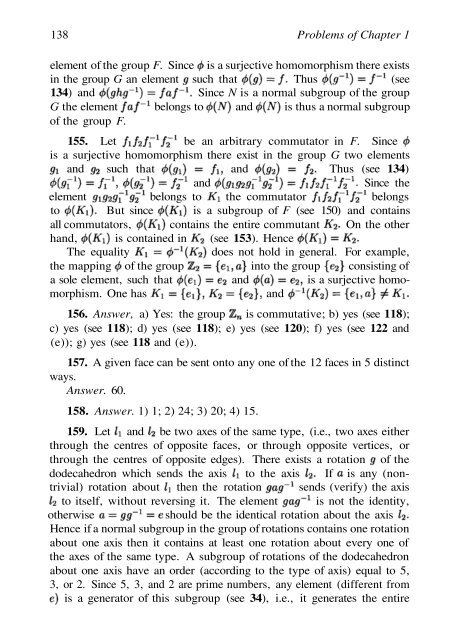Abel's theorem in problems and solutions - School of Mathematics
Abel's theorem in problems and solutions - School of Mathematics
Abel's theorem in problems and solutions - School of Mathematics
Create successful ePaper yourself
Turn your PDF publications into a flip-book with our unique Google optimized e-Paper software.
138 Problems <strong>of</strong> Chapter 1<br />
element <strong>of</strong> the group F. S<strong>in</strong>ce is a surjective homomorphism there exists<br />
<strong>in</strong> the group G an element such that Thus (see<br />
134) <strong>and</strong> S<strong>in</strong>ce N is a normal subgroup <strong>of</strong> the group<br />
G the element belongs to <strong>and</strong> is thus a normal subgroup<br />
<strong>of</strong> the group F.<br />
155. Let be an arbitrary commutator <strong>in</strong> F. S<strong>in</strong>ce<br />
is a surjective homomorphism there exist <strong>in</strong> the group G two elements<br />
<strong>and</strong> such that <strong>and</strong> Thus (see 134)<br />
<strong>and</strong> S<strong>in</strong>ce the<br />
element belongs to the commutator belongs<br />
to But s<strong>in</strong>ce is a subgroup <strong>of</strong> F (see 150) <strong>and</strong> conta<strong>in</strong>s<br />
all commutators‚ conta<strong>in</strong>s the entire commutant On the other<br />
h<strong>and</strong>‚ is conta<strong>in</strong>ed <strong>in</strong> (see 153). Hence<br />
The equality does not hold <strong>in</strong> general. For example‚<br />
the mapp<strong>in</strong>g <strong>of</strong> the group <strong>in</strong>to the group consist<strong>in</strong>g <strong>of</strong><br />
a sole element‚ such that <strong>and</strong> is a surjective homomorphism.<br />
One has <strong>and</strong><br />
156. Answer‚ a) Yes: the group is commutative; b) yes (see 118);<br />
c) yes (see 118); d) yes (see 118); e) yes (see 120); f) yes (see 122 <strong>and</strong><br />
(e)); g) yes (see 118 <strong>and</strong> (e)).<br />
157. A given face can be sent onto any one <strong>of</strong> the 12 faces <strong>in</strong> 5 dist<strong>in</strong>ct<br />
ways.<br />
Answer. 60.<br />
158. Answer. 1) 1; 2) 24; 3) 20; 4) 15.<br />
159. Let <strong>and</strong> be two axes <strong>of</strong> the same type‚ (i.e.‚ two axes either<br />
through the centres <strong>of</strong> opposite faces‚ or through opposite vertices‚ or<br />
through the centres <strong>of</strong> opposite edges). There exists a rotation <strong>of</strong> the<br />
dodecahedron which sends the axis to the axis If is any (nontrivial)<br />
rotation about then the rotation sends (verify) the axis<br />
to itself‚ without revers<strong>in</strong>g it. The element is not the identity‚<br />
otherwise should be the identical rotation about the axis<br />
Hence if a normal subgroup <strong>in</strong> the group <strong>of</strong> rotations conta<strong>in</strong>s one rotation<br />
about one axis then it conta<strong>in</strong>s at least one rotation about every one <strong>of</strong><br />
the axes <strong>of</strong> the same type. A subgroup <strong>of</strong> rotations <strong>of</strong> the dodecahedron<br />
about one axis have an order (accord<strong>in</strong>g to the type <strong>of</strong> axis) equal to 5‚<br />
3‚ or 2. S<strong>in</strong>ce 5‚ 3‚ <strong>and</strong> 2 are prime numbers‚ any element (different from<br />
is a generator <strong>of</strong> this subgroup (see 34)‚ i.e.‚ it generates the entire

















